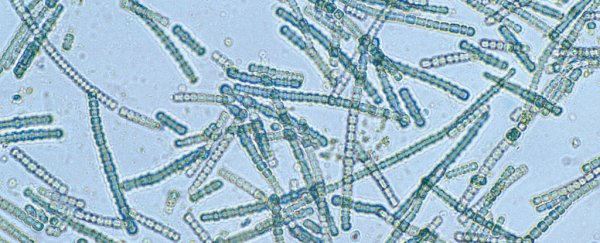While some blue-green algae (or more accurately - cyanobacteria) are critical to us for their nitrogen-fixing abilities, others can also become dangerous pests of our own making.
Climate change and agricultural run-off are causing a once normal environmental process to spiral out of control more often, and a new study has shown that a particularly dangerous toxin produced by cyanobacteria is not just hitching a ride in water, but also in our air in some cases.
The toxin, called anatoxin-a (ATX) or Very Fast Death Factor (no, we're not kidding), does what it says on the tin - kills things fast. If you are unfortunate enough to be exposed it can cause a loss of coordination, paralysis, or death in humans and other animals.
"ATX is one of the more dangerous cyanotoxins produced by harmful algal blooms, which are becoming more predominant in lakes and ponds worldwide due to global warming and climate change," explains first author James Sutherland from the Nantucket Land Council.
ATX is produced by a range of cyanobacteria that bloom in warm, still, nutrient-rich water, and it can disrupt the rest of the ecosystem.
In harmful algal blooms (HAB), the cyanobacteria lower the oxygen levels of the water and can sometimes produce toxins such as ATX.
Then, once the bloom dies, the microbes that decompose the algae use even more oxygen, which can create mass fish die-offs and even dead zones.
Usually, when water authorities spot an algal bloom, they make sure that humans stay well clear of the water because of the danger that toxins such as ATX can cause. However, there's still been a number of hospitalizations, and many deaths of dogs and other animals from ingesting the water.
But researchers at the Nantucket Land Council wanted to know if the air surrounding the bloom was also dangerous.
"Although no previous studies have documented the capture of airborne ATX molecules or cyanobacteria cells containing ATX, we hypothesized that ATX could become airborne under certain environmental conditions," the team write in their new paper.
The team investigated Capaum Pond, a freshwater pound in Nantucket, Massachusetts, known for regular summer HABs.
They collected samples from the area between July to October 2019, both in the water itself, and the air around the edge of the pond.
ATX was found in quite high concentrations in the body of water - on one particular day - 11 September 2019 - the team recorded 21 nanograms per milliliter.
On that windy and foggy September day, the team also detected ATX in the air around the pond. They found an average concentration of 0.87 nanograms per filter, which corresponds to a potential airborne exposure of 0.16 nanograms per meter squared.
"People often recreate around these lakes and ponds with algal blooms without any awareness of the potential problems," said Sutherland.
"Direct contact or inhalation of these cyanotoxins can present health risks for individuals, and we have reported a potential human health exposure not previously examined."
The team isn't sure yet how the toxin is ending up in the air, and aerosol exposure to ATX isn't well understood, so there's plenty more to investigate here.
The researchers suggest in the paper that perhaps the wind caused small droplets filled with ATX molecules, or even the cyanobacterial cells, to become airborne, and the fog helped the ATX stay in the air for longer.
In the meantime, best to stay away from bodies of water with algal blooms - especially on days with lots of wind or fog, lest you become an unwitting case study into the Very Fast Death Factor.
The research has been published in Lake and Reservoir Management.
